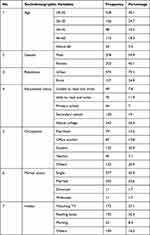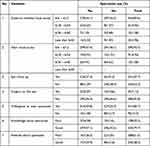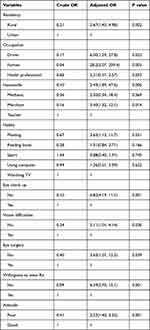Back to Journals » Clinical Optometry » Volume 15
Spectacles Under Utilization and Associated Factors Among Adults in Hawassa, South Ethiopia, June, 2022
Authors Gebresellassie MG , Sisay H, Desta K
Received 1 August 2023
Accepted for publication 14 December 2023
Published 19 December 2023 Volume 2023:15 Pages 303—311
DOI https://doi.org/10.2147/OPTO.S426032
Checked for plagiarism Yes
Review by Single anonymous peer review
Peer reviewer comments 3
Editor who approved publication: Mr Simon Berry
Mikael Girum Gebresellassie, Helen Sisay, Kindea Desta
Department of Optometry, College of Medicine and Health Science, Hawassa University, Hawassa, Ethiopia
Correspondence: Mikael Girum Gebresellassie, Department of optometry, College of medicine and health science, Hawassa University, Hawassa, Ethiopia, Tel +251943503633, Email [email protected]
Background: The commonest and cheapest treatment modality for correcting refractive error is spectacles or eyeglasses. In Ethiopia, the rate of spectacles under utilization and its impact on visual impairment was not known.
Objective: To assess spectacles under utilization and associated factors among adults in Hawassa, Ethiopia, 2022.
Methods and Materials: Community-based cross-sectional study design was conducted from Jan 2021 to May 2022 with a final sample size of 664. Multi-stage random sampling technique was used during the sampling process. Using an interviewer-based questionnaire, the selected individuals were asked about demographic characteristics, spectacles use, and satisfaction with spectacles, knowledge, and attitude about spectacles. An odds ratio with a 95% CI was used to display the results. A P-value less than 0.05 in multivariate logistic regressions is used to show statistical significance.
Results: The prevalence of spectacles under utilization was 307 (48.7%). The spectacles under utilization was more prevalent in individuals with unaided visual acuity of 6/6 − 6/12 (46.1%), no eye checkup (38.4%), no surgery on the eye (46.6%), willingness to accept spectacles (35.9%), good knowledge about spectacles (32.6%) and poor attitude about spectacles (35%). The most common reasons for not utilizing spectacles were believed not necessary (14.9%), expensive cost (13.1%), and discomfort (11.4%). Among the spectacles users (33.64%) who wore spectacles for 2 years, 31.17% procured the spectacles without physician orders and 46.6% purchased the spectacles in the optical workshop. The most common purpose to use spectacles was for protection (41.4%).
Conclusion and Recommendation: The spectacles under utilization in Hawassa town was high. Rural residency, occupation, eye check, eye surgery, no willingness to wear spectacles, and attitude towards spectacles were significantly associated with spectacles under utilization. It is necessary to provide health education to improve the poor attitude regarding spectacles and eye checks.
Keywords: spectacle, Hawassa, refractive error
Introduction
Spectacles, or eyeglasses, are an ophthalmic device usually used to improve vision and ocular protection which is the most common treatment modality for correcting refractive error.1
Refractive error is a biological variation of the ocular media that fails to bring parallel rays of light to focus on the fovea. Myopia, hyperopia, and astigmatism are the types of refractive error with the commonest symptoms being reduced vision, eye strain, double vision, and headache.2
Unfortunately, 670 million people are still with uncorrected refractive error (URE) due to a lack of optical treatment. Mostly, 90% of people with URE are of low socioeconomic status. Uncorrected refractive error is a major leading cause of visual impairment by affecting not only visual acuity but also having an impact on day-to-day quality of life.3
Poor social and familial acceptance is the common reason half of the people who need spectacles do not wear them adequately.4
Factors associated with non-compliance with spectacles wear included lack of felt need (58%), spectacles intolerance (28%), and ignorance (14%).5
Dissatisfaction with the spectacles is the cause for 2.3% of patients returning for refraction after spectacles were dispensed.6
Spectacles wearing were significantly higher among older people, rural children and those with myopia and hyperopia.7
Ethiopia is one of the developing countries in Africa, with relatively poor eye care service, but with the available eye care service and optical glass delivery, the rate is not known of spectacles under utilization before or after getting prescriptions and for how long they were using their eyeglasses. So, it was significant to understand the influence of spectacles under utilization on the magnitude of uncorrected refractive error. Moreover, there was limited information about whether spectacles are affordable and/or available as well as how they are utilized in the study area.
The community-based cross-sectional study design was conducted from Jan 2021 to May 2022. Sample size was determined by using a single population proportion formula with (P) prevalence taken from a study done in Gondar, Ethiopia estimated at 25%.
A sample size of 422 individuals was calculated based on the assumption of a 5% expected marginal error and 95% confidence interval.
Where: n = sample size calculated
Z = level of significance
d = margin of error
n = (1.96) 2 *(0.25*0.75)/ (0.05) 2
n = 301.
By calculating 10% non-respondent rate, the sample size was 332. After considering 2x designing effects, the final sample size was 664.
Multi-stage random sampling technique was used during the sampling process. Households from each district were selected by using systematic random sampling with proportional allocation and calculated K (n/N) interval. Within the selected household one person in the house, who was 18 years and above, was selected by using the convenience sampling technique. The selected individual was interviewed about spectacles use and examined for distance and near visual acuity using Snellen VA and ETDRS reading chart. The collected data were cleaned and coded, EPI info 2002 for data entry, and SPSS version 16.0 software for data analysis were used. Descriptive analysis for demography data was computed. Binary logistic regression was computed to identify associated factors. Factors with a P-value of less than 0.2 on bivariate analyses were entered into multivariate logistic regressions to identify the strength of association with the dependent variable. An odds ratio with a 95% CI was used to display the results. A P-value less than 0.05 was used to show statistical significance.
Operation Definition
Spectacles Under Utilization
Spectacles not used for the last 6 months continuously while it is needed for visual reduction, protection or other reasons.
Spectacle Utilization
If an individual has spectacles to hand or reported using it for the last 6 months continuously.
Poor Knowledge
50% wrong answers to knowledge-related questions regarding spectacles.
Poor Attitude
50% wrong answers to knowledge-related questions regarding spectacles.
Result
Socio-Demographic Characteristics
In this study, 631 participants were involved, among them 228 (36.1%) were 18–25 years of age, male 378 (59.9%), urban 474 (75.1%), educational status above college 343 (54.4%), students 132 (20.9%), married 332 (52.6%) and book readers 192 (30.4%) (Table 1).
 |
Table 1 The Socio-Demographic Characteristics of the Study Participants in Hawassa Town, 2022 |
Spectacles Under Utilization
The prevalence of spectacles under utilization was 307 (48.7%). Spectacles under utilization was more prevalent in individuals in the age group 18–25 years 117 (17.6%), male 180 (27.1%), urban 188 (28.4%), above college 129 (19.5%), students 64 (9.65%), married 154 (23.2%) and book readers 83 (12.5%) (Table 2).
 |
Table 2 The Prevalence of Spectacles Under Utilization with Different Socio-Demographic Variables of the Study Participants, 2022 |
The spectacles under utilization was more prevalent in individuals with unaided visual acuity of 6/6 −6/12, 291(46.1%), no eye check-up 242 (38.4%), no surgery on the eye 294 (46.6%), positive willingness to accept spectacles 227 (35.9%), good knowledge about spectacles 206 (32.6%) and poor attitude about spectacles 221(35%) (Table 3). The most common reasons for not utilizing spectacles were believed not necessary 46 (14.9%), expensive cost 40 (13.1%), and discomfort 35 (11.4%) (Figure 1).
 |
Table 3 The Proportion of Spectacles Use with Different Independent Clinical Variables, 2022 |
 |
Figure 1 The common reasons individuals’ not using spectacles in Hawassa town, 2022. |
Among the spectacles users, 109 (33.64%) wore spectacles for 2 years and above and 145 (44.75%) replaced their glasses once. From them, 101 (31.17%) procured the spectacles without physician orders, and 151 (46.6%) purchased them in the optical workshop.
Factors Associated with Spectacles Under Utilization
Multinomial logistic analysis between spectacles under utilization and the predisposing factors were analyzed, as a result, rural residency (OR = 2.67 (1.42, 5.00)), drivers (OR = 7.83 (1.68, 36.59)), students(OR = 4.86 (1.52, 15.48)), housewife (OR = 9.39 (1.90, 46.28)), farmer (OR = 25.64 (2.46, 267.41)), merchant (OR = 3.53 (1.15, 10.87)), office worker (OR= 3.75 (1.29, 10.92)), eye check up (OR = 7.81 (4.85, 12.56)), eye surgery (OR = 4.27 (1.25, 14.56)), no willingness to use spectacles (OR = 6.34 (2.70, 14.86)) and attitude regarding spectacles (OR= 2.22 (1.39, 3.53)) were significantly associated with spectacles under utilization (Table 4).
 |
Table 4 Factors Significantly Associated with Spectacles Under Utilization with Multinomial Logistic Regression, 2022 |
Discussion
In this study, the prevalence of spectacles under utilization was 48.7% which is higher than the studies done in Ghana, Telangana, China, Andhra Pradesh, and Gondar that were 39.4%, 38.5%, 35.2%, 28.8%, and 25% respectively. The difference in the characteristics of the study participants, socio-economic status and the sample size between those studies may cause the variation.5,7–11
The most common reason reported in this study for not utilizing spectacles was believed not necessary 46 (14.9%), expensive cost 40 (13.1%), and discomfort 35 (11.4%) which is similar to the study done in Ghana and India but in Rawalpindi the most responded reason was cosmetics reason (64.5%).8,11,12
This study reveals multiple factors have a strong and significant association with spectacles under utilization but in China negative attitude regarding spectacles (OR = 0.49; 95% CI, 0.25–0.97), and poorer uncorrected VA (OR = 31.27; 95% CI, 3.76–260.23) were the only independent determinants for spectacles under utilization. There is a similarity between those studies on the association between poor attitudes about spectacles and spectacles under utilization. In addition, in this study, a poor attitude has a larger impact on spectacles under utilization than poor knowledge about spectacles.9
Among the individuals who utilized spectacles previously 35 (10.8%) of them were not satisfied with their spectacles and the most common reasons for their dissatisfaction with the spectacles were adaptation fear and problems, discomfort, vision not being clear and lens scratches. Most of them used plastic frames 252 (77.8%) and the most common type of frame used was round full rim 132 (40.7%) and square full rim 157 (48.46%). The most common purpose for utilizing spectacles was protection (41.4%) and near vision correction (15.5%) (Figure 2). The common type of eyeglass used was Plano photo solar (41%) (Figure 3).
 |
Figure 2 The most common purpose of the spectacles used in Hawassa town, 2022. |
 |
Figure 3 Shows the most common type of eyeglass spectacles used in Hawassa town, in 2022. |
Limitations
The study design was cross-sectional so, it is a one-spot analysis and will fail to analyze the direct cause-and-effect relationship.
The sample size was not adequate to represent and reveal the full magnitude of the problem.
Conclusion
The spectacles under utilization in Hawassa town was high. Rural residency, occupation, eye check, eye surgery, willingness to wear spectacles, and attitude towards spectacles were significantly associated with spectacles under utilization. The most common reason to not utilize spectacles was a belief not necessary, cost, and discomfort with spectacles.
Ethical Approval and Informed Consent
This study was conducted in line with the Declaration of Helsinki. A formal authorization paper was acquired from the Hawassa university CMHS, institutional review board (IRB). Following an explanation of the study’s objectives, written informed consent was obtained from each study participant, and each study subject was informed of their right to withdraw from the study at any moment throughout the interview and examination. The study participants’ information was confidential.
Disclosure
The authors declare that there are no conflicts of interest in this work.
References
1. Ayanniyi AA, Adepoju FG, Ayanniyi R, et al. Challenges, attitudes and practices of the spectacle wearers in a resource-limited economy. Middle East Afr J Ophthalmol. 2010;17(1):83. doi:10.4103/0974-9233.61223
2. The Eye Disease Prevalence Research Group. The prevalence of refractive error among adults in the United States, Western Europe, and Australia. Arch Ophthalmol. 2004;122:495–505. doi:10.1001/archopht.122.4.495
3. Kobia-Acquah E, Essien E, Ablordeppey R. Attitudes and beliefs of undergraduate students to spectacle Wear Akosombo, Ghana. AOVS. 2017;8:264.
4. Priya M, Addressing acceptance of spectacle amongst children; 2017.
5. Desalegn A, Tsegaw A, Shiferaw D, Woretaw H. Knowledge, attitude, practice and associated factors towards spectacles use among adults in Gondar town, northwest Ethiopia. BMC Ophthalmol. 2016;16(1):1. doi:10.1186/s12886-016-0357-3
6. Li L, Lam J, Lu Y, et al. Attitudes of students, parents, and teachers toward glasses use in Rural China. Arch Ophthalmol. 2010;128(6):759–765. doi:10.1001/archophthalmol.2010.73
7. Marmamula S, Challa R, Khanna RC. Spectacle use in a rural population in the state of Telangana in South India. Invest Ophthalmol Vis Sci. 2016;57(12):3972.
8. Acquah EK, Essien E, Ablordeppey R, et al. Attitudes and beliefs of undergraduate students to spectacle wear in Ghana. Adv Ophthalmol Vis Syst. 2018;8(1):
9. Qian D-J, Zhong H, Jun L, Liu H. Spectacles utilization and its impact on health-related quality of life among rural Chinese adolescents. Royal Coll Ophthalmol Eye. 2018;32:1879–1885. doi:10.1038/s41433-018-0197-x
10. Li L, Song Y, Liu X, et al. Spectacle acceptance among secondary school students in Rural China: the Xichang Pediatric Refractive Error Study (X-PRES)—report 5. Invest Ophthalmol Vis Sci. 2008;49(7):2895–2902. doi:10.1167/iovs.07-1531
11. Marmamula S, Ravuri LV, Boon MY, et al. Spectacle coverage and spectacles use among elderly population in residential care in the South Indian State of Andhra Pradesh. Biomed Res Int. 2013;2013:1–5. doi:10.1155/2013/183502
12. Mohammad K, Atif I, Rashid F. Reasons for the refusal of spectacle usage among medical students of Rawalpindi and Islamabad. Islam Int Med Coll. 2020;15:3.
 © 2023 The Author(s). This work is published and licensed by Dove Medical Press Limited. The full terms of this license are available at https://www.dovepress.com/terms.php and incorporate the Creative Commons Attribution - Non Commercial (unported, v3.0) License.
By accessing the work you hereby accept the Terms. Non-commercial uses of the work are permitted without any further permission from Dove Medical Press Limited, provided the work is properly attributed. For permission for commercial use of this work, please see paragraphs 4.2 and 5 of our Terms.
© 2023 The Author(s). This work is published and licensed by Dove Medical Press Limited. The full terms of this license are available at https://www.dovepress.com/terms.php and incorporate the Creative Commons Attribution - Non Commercial (unported, v3.0) License.
By accessing the work you hereby accept the Terms. Non-commercial uses of the work are permitted without any further permission from Dove Medical Press Limited, provided the work is properly attributed. For permission for commercial use of this work, please see paragraphs 4.2 and 5 of our Terms.
